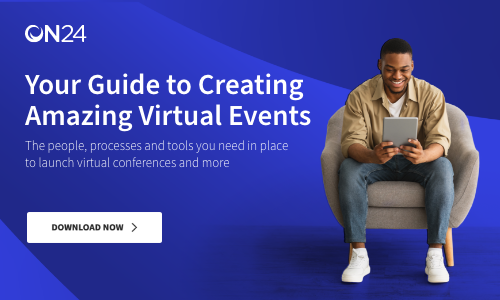Top Tips for Creating Impactful B2B Virtual Events

B2B marketers know that having a presence at an event—whether hosting, sponsoring, or partnering—is an effective tactic that generates leads and demand and boosts brand awareness.
But physical events are expensive, time-consuming and demand a lot of work. And, sometimes, they don’t work out.
Enter the virtual event. Virtual events can simplify events for B2B marketers, save on costs and provide all of the benefits of a physical event at digital scale.
To show you how, we’ve compiled the top tips for creating a powerful B2B virtual event strategy that can meaningfully contribute to your business goals.
Understanding B2B Virtual Events

B2B virtual events use digital technology to facilitate an online gathering that allows for remote participation, often centered around knowledge-sharing and networking.
Virtual events have become increasingly significant in recent decades, and their unique benefits make them a strong complement to in-person events in a B2B event marketing strategy. Thanks to the possibility of remote attendance, virtual events can connect with a much wider audience and are generally much more cost-effective than in-person equivalents.
They’re also extremely flexible – virtual events can be delivered in lots of different formats, including webinars, virtual conferences, symposiums, and online workshops.
These different formats are best suited to achieving different goals. A webinar, for example, is a great format for delivering valuable content to educate and nurture leads, while a workshop is perfect for explaining new product features to existing customers.
Planning Your Virtual Event

Thorough planning is essential to provide a solid foundation for any virtual event, ensuring it runs smoothly and contributes to business objectives. The planning phase involves several core steps.
Define Clear Objectives
Establishing specific and measurable objectives should be the first step in any virtual event planning process. Importantly, they should be chosen for your broader business goals. If your business goal is to increase revenue, for example, generating a certain number of leads could be your virtual event objective.
Know Your Audience
The topic, content, and structure of your virtual events should all be tailored to your target audience to ensure it resonates with them. Research, whether carried out through surveys or reviewing existing audience analytics data, can help you build an understanding of your audience, delivering insights that will make it easier to create an event that appeals to them.
Choose the Right Platform
A virtual event’s success partly depends on using the right platform to host it. Virtual event platforms can include diverse features, but you should choose the one that best fits your needs. It should have a user interface you can master, scalability that makes it suitable for your audience size, and any audience engagement capabilities you plan on using.
The ON24 Intelligent Engagement Platform offers all of the features needed for planning, hosting, and analyzing a B2B virtual event, including content personalization tools, 20+ audience engagement features, and an AI-powered analytics engine.
Creating Engaging Content

A B2B virtual event is only as good as its content, and ensuring it’s engaging should be a high priority. This ensures your attendees stay interested throughout the event while also maximizing how much engagement data you have to analyze afterward. Here are some top tips for creating engaging B2B virtual event content.
Create a Compelling Agenda
Virtual events should be structured strategically to maximize engagement. Depending on the type of event you’re hosting, try to balance speaker-led educational sections with interactive elements. Also, prioritize using different content formats like keynotes, panels, and breakout sessions to add variety to the way you deliver information. Both of these strategies will minimize the chance that your audience gets bored or loses interest, keeping them engaged for longer.
Incorporate Interactive Features
One key benefit of virtual events compared to in-person events is the ability to integrate interactive elements, which can play an important role in keeping attendees engaged. Live polls, Q&A sessions, and chat rooms can all help to break up non-interactive content or speaker slots, giving your audience time to absorb information and reducing the likelihood of them losing interest. Incidentally, these features can also help you collect useful engagement data that you can use to inform strategy in subsequent campaigns.
Leverage Multimedia
Making full use of multimedia assets like videos, infographics and animations alongside speakers and slideshows creates a more immersive and engaging event experience. Integrating these multimedia assets into your presentations as seamlessly as possible rather than using them as standalone sections. This will help make your overall message easier to convey, maximizing its value for the audience.
Promoting Your Virtual Event

Even the best B2B virtual events wouldn’t attract attendees without proper promotion. Marketing your event is just as important as creating it to ensure that it delivers on the objectives you set. Use these strategies to make your marketing more effective.
Use Multi-Channel Marketing
The audience for your virtual event can likely be found across multiple channels, so targeting them with multi-channel marketing is one of the best ways to generate interest. Social media marketing, search engine optimization (SEO) and email marketing can be used together in multi-channel campaigns to reach target demographics again and again across different platforms.
Personalize Invitations and Follow-Ups
Personalization isn’t just nice to have for B2B marketers; it’s essential. In fact, according to an ON24 survey, only 1% of B2B marketers do not use personalization in some form.
When it comes to virtual event marketing, personalization can influence registration and attendance rates — especially when paired with follow-ups or reminders. Go beyond basic personalization by tailoring your pre-event communications to specific audience segments. This could include adapting the messaging style and recommended content to suit each segment’s pain points or preferences.
Ensuring Seamless Execution

The final ingredient of a successful virtual event is practice. You need to ensure your event runs smoothly, from technical execution to presentation skills.
Prepare Speakers and Moderators
Speakers and moderators play a key role in dictating the flow of your event and keeping the audience engaged. To do this effectively, they need to be given plenty of time to prepare and learn the event’s structure inside and out. Having a full webinar rehearsal in the days leading up to the event date is also extremely valuable, offering a final opportunity to troubleshoot any potential problems.
Test Technology in Advance
Failure in the technology you use to facilitate your event, from the event hosting platform itself to speakers’ microphones, can be catastrophic. To mitigate the chances of any unforeseen technological problems, create a full tech checklist that you can run through in the days leading up to the event. It should include a test of every technology you plan on using, including your event hosting platform, internet connectivity, microphones and webcams.
Engage Attendees in Real-Time
During the event, use all of the engagement features you can access, interspersing engagement-focused sections within each session. This can be live Q&A sessions, polls, and quizzes. It’s useful to have moderators to guide these engagement sections by answering questions in the virtual event’s live chat to ensure everybody knows how to get involved.
Post-Event Follow-Up

Don’t let your virtual event end after the final session – post-event follow-up provides a perfect opportunity to maintain engagement with your audience at large and individual leads to build on your event’s success. Here’s how to handle post-event activities.
Analyze Event Data
Your B2B virtual event will likely generate a lot of data you’ll need to unpack and analyze after the event ends. Metrics covering sign-ups, attendance, and event engagement can all provide valuable insights into where your virtual event succeeded and where it fell short. This can be instrumental in guiding the process, ensuring that your next event delivers even more results.
Follow-Up with Attendees
Timely personalized follow-ups with attendees can keep them engaged with your brand and, if your event objective was based on lead generation, offers an opportunity to nurture leads. Delivering a recap of the event and additional content tailored to specific audiences is a particularly effective way of keeping the momentum going.
Gather Feedback
Finally, gather feedback from your attendees by using post-event surveys or custom feedback forms delivered via email. This will give you some direct insights into how they enjoyed the event, what topics were most interesting, and what they’d like to hear more about. You can also ask where they learned about the event to inform marketing strategies for future events. Make sure to encourage honest and constructive feedback to maximize its value.



